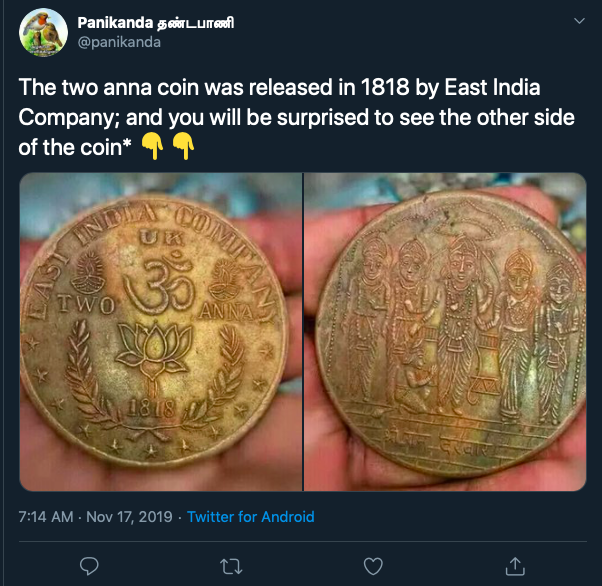Viral images of coins minted in 1818 by East India Company are nothing but a fantasy creation
Claim 1: “One Anna Coin issued by the British Indian Government in the year 1818 on the occasion of Jain Festival of Akshay Tritya.The coin depicts Tirthankar Rishabhdev accepted sugarcane juice from king Shreyans and breaking his one year fast.”
Claim 2: “Do you know that two Anna Coin was released in 1818 by East India Company; & you’ll be surprised to see the other side of the coin (there’s Lord Ram, Laxman & Sita)”
A series of images have resurfaced on social media claiming that the money coins have been minted by the British East India Company in 1818.
One the day of Akshaya Tritiya, this post has gone viral claiming that the British minted these in 1818 on the occasion of Akshaya Tritiya, a Jain festival.
The post was shared extensively on Facebook,

This particular image of the coin was also shared, with it being shared over 6.5k times
The image of the coin claimed to have minted by the British on the occasion on Akshaya Tritiya, was shared on Twitter as well,
One Anna Coin issued by the British Indian Government in the year 1818 on the occasion of Jain Festival of Akshay Tritya.The coin depicts Tirthankar Rishabhdev accepted sugarcane juice from king shreyans and breaking his one year fast (varshi Tap).#AkshayaTritiya2020 pic.twitter.com/269xOCqVju
— Anupama Raag (@anupamaraag1) April 26, 2020

This coin is from the year 1818 East. Make money in India by the East India Company, then the money is a lotus flower in the middle of the city.@narendramodi @England @nsitharamanoffc @amitmalviya @anandmahindra @ombirlakota @OmMathur_bjp @chitraaum @anuraagmuskaan pic.twitter.com/LfZoi7T6SW
— Vikramsingh (@Vikramsingh813) April 23, 2020
Truth
When the same images of the coin featuring the ‘Om’ symbol, Lotus and Lord Rama, Sita and Lakshman, had gone viral last year, Alt News had spoken to numismatist and author Mohit Kapoor for more information. Mr. Kapoor is the regional secretary for the South Asian chapter of the Oriental Numismatic Society.
He said, “All of these are fantasy issues as the East India company never minted any coins of this type. Moreover, the years that these pieces have on 1616, 1717, and 1818 had hand struck coinage whereas these fantasy pieces are all struck using machines. Another thing that clearly points out that these are fantasy issues is the denominations that are inscribed on these pieces. Specific denominations were struck in specific metals, a 2 Anna would be in silver and not in copper. In fact, the earliest example of a 2 Anna in Copper-Nickel alloy is the one struck in 1919, which too saw stiff resistance by the general population as they were used to the denomination being in Silver.”

British trading was established in India in the early seventeenth century by the East India Company, factories came up in Masulipatnam, Madras in the south, Surat in the west, and Kolkata in the east. These establishments gave rise to the Bengal Presidency, the Bombay Presidency, and the Madras Presidency. Each Presidency decided to have a coinage system of theri own.
Although in 1835, the East India Company decided to have a unified monetary system across all British possessions in India and the older Presidency system was discontinued.
After doing a search for coins that were minted in the British Era, we came across a website that had the collection of coins.
The below illustrations belong to the,
1. BENGAL PRESIDENCY
The coins bear the Persian, Bengali and Hindi Language. They are also hand struck unlike the machine struck images of the coin that are going viral. They were also minted on Copper and Silver.


2. BOMBAY PRESIDENCY
The coins in the Bombay Presidency were also minted on Silver,

3. MADRAS PRESIDENCY
As far as the Madras Presidency is concerned, they did print Gopuram (also known as Pagoda) and Lord Vishnu on the reverse side on their coins.
Mr. Mohit Kapoor, when he spoke to Alt News confirmed it saying, “The Bombay and Calcutta Presidencies struck Silver coins in the names of the Mughal Emperors, however, the Madras Presidency struck gold and silver coins (for a very brief period) which had the image of Lord Vishnu on one side and the image of a temple gopuram on the other.”

To get more clarity, we scanned the Coinage Museum on Reserve Bank of India’s website and found no coin images that are viral, or anything similar.

Nothing of that sort was also found during the rule of William IV, Queen Victoria, Edward VII and George VI.
The coins that have gone viral are nothing but fantasy creations that are easily available online.
CONCLUSION:
Hence, there are no coins that were minted by East India Company featuring the ‘Om’ symbol, Lotus flower or featuring ‘Lord Rama, Sita and Lakshman’, neither did they mint any coins depicting, “Lord Rishabhdev accepting sugarcane juice from King Shreyans on the occasion of Akha Teej”. The coins are all a fantasy creation.




